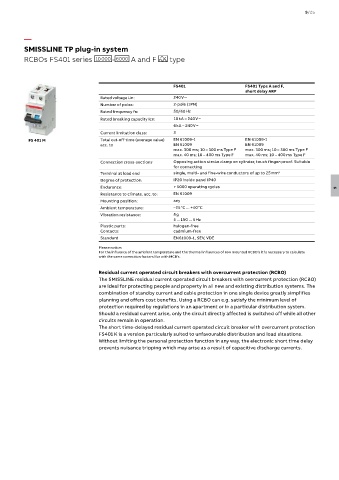Page 855 - Din prodcuts 2020
P. 855
9/25
—
SMISSLINE TP plug-in system
RCBOs FS401 series 10 000 - 6000 A and F y type
FS401 FS401 Type A and F,
short delay ARP
Rated voltage Un: 240 V ~
Number of poles: 2-pole (1PN)
Rated frequency fn: 50/60 Hz
Rated breaking capacity Icn: 10 kA – 240 V ~
6 kA – 240 V ~
Current limitation class: 3
FS 401 M Total cut-off time (average value) EN 61009-1 EN 61009-1
acc. to EN 61009 EN 61009
max. 300 ms; 10 – 300 ms Type F max. 300 ms; 10 – 300 ms Type F
max. 40 ms; 10 – 400 ms Type F max. 40 ms; 10 – 400 ms Type F
Connection cross-sections Opposing action stroke clamp on cylinder, touch finger-proof. Suitable
for connecting
Terminal at load end single, multi- and fine-wire conductors of up to 25 mm 2
Degree of protection: IP20 inside panel IP40
Endurance: > 5000 operating cycles 9
Resistance to climate, acc. to: EN 61009
Mounting position: any
Ambient temperature: –25°C ... +40°C
Vibration resistance: 5 g
5 ...150 ... 5 Hz
Plastic parts: halogen-free
Contacts: cadmium-free
Standard EN61009-1, SEV, VDE
Please notice:
For the influence of the ambient temperature and the thermal influences of row mounted RCBO’s it is necessary to calculate
with the same correction factors like with MCB’s.
Residual current operated circuit breakers with overcurrent protection (RCBO)
The SMISSLINE residual current operated circuit breakers with overcurrent protection (RCBO)
are ideal for protecting people and property in all new and existing distribution systems. The
combination of standby current and cable protection in one single device greatly simplifies
planning and offers cost benefits. Using a RCBO can e.g. satisfy the minimum level of
protection required by regulations in an apartment or in a particular distribution system.
Should a residual current arise, only the circuit directly affected is switched off while all other
circuits remain in operation.
The short time-delayed residual current operated circuit breaker with overcurrent protection
FS401 K is a version particularly suited to unfavourable distribution and load situations.
Without limiting the personal protection function in any way, the electronic short time delay
prevents nuisance tripping which may arise as a result of capacitive discharge currents.

